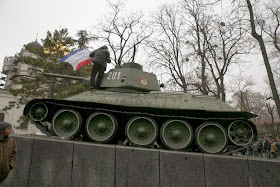by Benson Agoa | Natural Disaster
After making landfall at a speed of 200 miles per hour, Hurricane Patricia rapidly dissipated, but before it left in its wake, flooded homes and streets, stranded pets and cars, as well as fallen power lines.
The storm is called Hurricane Patricia and was originally traveling at 165 miles per hour, Fox News reports. It is considered the strongest hurricane ever recorded in the Western hemisphere.
 |
| * ISS Shot: Photo taken by an astronaut from the International Space Station. |
It quickly accelerated. Travelling at 200 miles per hour, Hurricane Patricia was categorized as C-5 Storm. But as quickly as it accelerated, it also dissipated rapidly as soon as it made landfall, dropping in category.
Soldiers was brought in to help search for people who may be in distress, and fallen power lines were quickly repaired. Soldiers using trucks, traveled round the flooded areas rescuing residents.
While all these may be routine for such circumstances, what may not be, is flying an aircraft into a live and accelerating storm.
 |
| * Hurricane Patricia gathered up 200 miles per hour |
Understanding storms is a big challenge for weather forecasters. And so while people run away from approaching storms, others are forced to head into them.
Storm chasers, for example, have been known to work towards storms, filming and shooting, to help understand and profile storms - with an overall view to predicting future ones, and ofcourse, avoiding or reducing their impacts.
Patricia which came with quickly increasing speed, notched up to 200 miles per hour, and according to Capt. R. Hunter of the US Airforce, heading into the strongest storm ever was the only way they get to understand them better.
Asked what he learnt and how the ride was inside the hurricane, he said Patricia thought him to respect mother nature, adding "it was a real bumpy one, which came with sever turbulence, a lot of rain and a small eye wall of 7 nautical miles in diameter.
But once inside the eye, they had to make everybody work really fast, and dropping the weather instruments. The associated difficulty was managed with the fact that the C-130 is a big aircraft.
The severity of Patricia meant that when the pilot looked through the eye, they could not even see through the sky, but found multiple lightening occurring as the plane flew past.
They needed to fly into it in orther to get a real-time data and help increase the forecast module for NHC (U.S. National Hurricane Center in Miami), because its the best way to get the best information - flying straight into the storm and releasing their instruments.
This Monday, it has reportedly made a landfall on Mexico's Pacific Coast early Friday evening.
 |
| * The storm from the sky. |
 |
| * A car was covered by fallen trees. |
 |
| * Soldiers search for people in dsitress. |
 |
| * The result of Patricia |
 |
| * A dog jumps to a place of safety, as its home was flooded |
 |
| * Soldiers use trucks to rescue trapped residents. |
* Credit to Fox News . Cable News Network (photos)


















































































































































































No comments:
Post a Comment